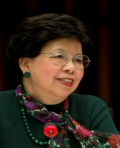
Much is written about the potential of ICT and eHealth to revolutionize the delivery of health care. Much less is written to demonstrate how this potential is being realized. I warmly welcome the Connect Asia-Pacific Summit and this ministerial session as opportunities to support the potential of eHealth with a concrete body of evidence and experience.
The connectivity made possible by ICT is sometimes described as the nervous system for a modern society. For health, it can be a lifeline, especially when it provides solutions to long-standing priority needs.
One of the biggest needs, everywhere, is for greater equality in access to health information and services. As noted a decade ago, in the Declaration of the World Summit on the Information Society, bridging the digital divide contributes to harmonious, fair and equitable development for all. Several regional development banks are likewise convinced that these technologies can have a transformative impact on health governance and service delivery
The world faces a critical shortage of around 4 million health workers, with the shortage most acute in the developing world. ICT solutions can help relieve the pressure on this workforce. They can extend the reach of scarce staff resources, especially to underserved rural areas. Such solutions are especially important given the years needed to train doctors and nurses and the number of medical graduates who leave the countries that invested in their training.
Some 85 countries, representing 60% of the world population, do not have adequate systems for civil registration and vital statistics. This lack of reliable data for monitoring progress leaves health programmes working in the dark. Accountability means counting. Among their collaborative efforts, WHO and ITU are working closely together to implement the recommendations of the UN Commission on Information and Accountability for Women’s and Children’s Health, including guidance on the development of national eHealth strategies.
Surveys undertaken by WHO in more than 50 developing countries show that essential medicines for the treatment of acute diseases are available in only slightly more than half of all public health facilities. For privately run facilities, this figure rises to 66%. This means that large numbers of people are leaving health facilities empty-handed. Electronic tracking of the movement of medicines through distribution channels can help prevent these stock-outs, as is being done in several developing countries.
I have been in developing countries where villages have no reliable electricity, running water, paved roads, or shoes for the children, but nearly everyone has a mobile phone. This is a resource that is not yet being fully, systematically, and sustainably tapped.
As participants at this ministerial meeting share their views on the region’s digital challenges and opportunities, I ask that you keep in mind the potential of these technologies to reduce the world’s vast social inequalities, including those that arise from uneven access to basic health services – that is, to make development truly inclusive.
Dr Margaret Chan
Director-General, World Health Organization
